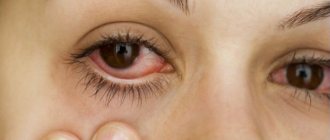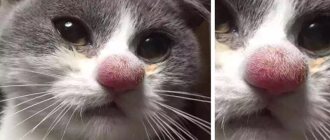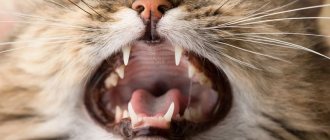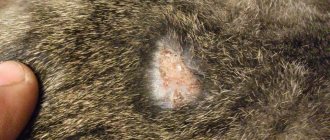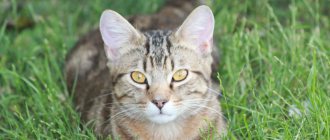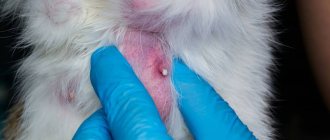As much as you love your feline companions, it's easy to worry about any new thing on their faces, from crusty eyes to nasal discharge. Blackheads often appear on your cat's nose, and this can be a cause for concern. So, have you ever wondered what that black thing is on a cat's nose?
The black stuff on your cat's nose is caused by boogers, mucous nasal discharge from dust, or scabs. Small spots of dried blood are signs of a bacterial infection. Feline herpes or lentigo can also cause discoloration of the nose.
It's good that you're paying attention too: cats' tears and other things on their faces can be an indicator of their health. Sometimes this discharge tells you that your cat is healthy, and sometimes this discharge can be the first sign of a problem and a sign that it is time to see a veterinarian.
Nose injuries
The crusts on your cat's nose may be brownish or black. This symptom is characteristic of a fungal infection, an inflammatory process in the nasopharynx, or an allergic reaction. The most harmless cause of crust formation is considered to be household injuries.
The fact is that a healthy cat's nose is slightly moist. This prevents the normal restoration of damaged skin, so wounds can take a long time to heal. If the owner is absolutely sure of the nature of the crusts, it is necessary to help the pet’s body recover as quickly as possible. To do this, it is recommended to treat your nose with an antiseptic several times a day. Preventing re-infection of the wound significantly accelerates regeneration and the crusts begin to disappear a few days after the start of treatment.
A dark crust on the nose, which is accompanied by discomfort and is a consequence of skin damage, should not be a cause for concern. In this case, no treatment is required; the crust will fall off on its own when the tissues are completely restored.
Treatment with an antiseptic is only necessary if weeping erosions or crusts appear at the site of the wound, blocking the respiratory tract.
Should you clean your cat's nose?
The short answer is yes , you should occasionally clean your cat's nose if she needs it. For example, if you have a cat with allergies, cleaning her nose will help her breathe easier and make her more comfortable.
Some kittens need their nose cleaned from time to time and outgrow it as adults.
Of course, if you need to clean your cat's nose regularly, it's a good idea to visit your veterinarian and find out why.
Cats are very sensitive in the facial area. This means that to clean their nose, they need to be calm and you need to be gentle. If crusts appear on your nose, be especially careful not to scratch or injure them.
Crusts on a cat's nose
The cause of sores and crusts on the nose in cats can be malignant neoplasms. Most often, this is squamous cell carcinoma that occurs on the skin and mucous membranes in the head area. The cause of the disease is excessive exposure to the sun. It is more common in areas with a warm climate and plenty of sunny days.
The risk group includes individuals who are white or have large white spots on their bodies. The likelihood of malignant degeneration increases as the animal ages and with increasing time spent outside the home during hours of active UV radiation (from 10-11 a.m. to 4-5 p.m.).
Symptoms of the disease:
- long-term non-healing erosions on the skin;
- dark red spots with a cauliflower-like surface;
- crusty, concave ulcerations surrounded by an edematous ridge.
When cancerous lesions become infected with bacteria or fungi, a film or plaque with an unpleasant odor appears on them.
If the sore does not heal within 10-15 days, and progression of symptoms is observed (expansion of the affected area, enlargement of lymph nodes, deterioration in the pet’s general well-being), you should consult a veterinarian. In the absence of adequate therapy, squamous cell carcinoma gradually not only destroys the nasal cavity, but also spreads to neighboring areas. As a result, the animal may die.
The diagnosis of the disease is carried out by a specialist. He prescribes a biopsy of the affected area and blood tests. If necessary, an MRI is performed and an X-ray is taken. Timely diagnosed squamous cell carcinoma responds well to treatment: the affected areas are surgically removed. If the tumor is small, it is subjected to laser ablation.
Causes of black spots on a cat's nose
There are many things that can happen to your cat that can cause a black spot to appear on its nose. Even small scraps of black fabric from one of their favorite toys may look like something you need to worry about until you take a closer look.
© shutterstock
You should also take a close look at any black things on your cat's nose if you usually wear black clothes or have dark furniture or carpeting. Lint and dust from these dark sources can easily get into your cat's nasal lining and cause dark discharge.
This is the mucous membrane that does its job and protects your cat's respiratory system. But if it's a common occurrence, consider vacuuming or scrubbing away possible sources of lint, or even keeping your cat away from the source. This is because black nasal discharge can sometimes be more serious, and you don't want to miss signs of illness due to lint.
Another less dangerous cause of black spots on your cat's nose could be a small scratch on the surface of the nose and the scab has dried out. If you have multiple cats at home, it is not uncommon to find small scratches on your cat's face. Cats are territorial and will often use their claws to force another cat to retreat if hissing and fluffing their fur doesn't help.
Nose scratches are more common in cats when a new cat first arrives, but can occur at any time while two cats live together.
Your cat may also accidentally scratch its nose while playing alone, especially if your cat is allowed to go outside.
Your cat's nose is relatively sensitive, so they may find it a little uncomfortable if it is scratched. Luckily, the scratches are usually not that serious. Just keep an eye on them to make sure they keep the scratch clean and don't rub too hard. If your cat starts pawing at her face or her nose appears redder or swollen, it's time to see a veterinarian in case the scratch is infected.
Calcivirosis
Calcivirosis is a dangerous viral disease of cats. In addition to the nose and oral cavity, the infection can affect the respiratory, hematopoietic and nervous systems of animals, and the digestive organs. The disease is often severe, with symptoms appearing within 1-3 weeks, and about a third of those affected die. Survivors are able to shed the virus into the environment for up to 12 months. With stress, deterioration of living conditions, infection with VLK or FIV, a relapse of calicivirus occurs. If a secondary infection occurs, the mortality rate increases to 80%.
To avoid death, you need to show the animal to a veterinarian as soon as possible.
What are blackheads in cats and why are they dangerous?
Blackheads (acne) are clogged sebaceous glands. The characteristic dark head occurs when sebum oxidizes. The appearance of such symptoms in an animal may indicate disturbances in the functioning of the body, the presence of parasites. Such a problem cannot be ignored.
Black spots can trigger the occurrence of furunculosis, which is characterized by a purulent process occurring in the inflamed sebaceous gland. This condition is dangerous for the pet’s health and can contribute to the spread of infection. Outdoor animals are most susceptible to acne, but comedones can also occur in indoor cats.
Blackheads in cats are caused by blocked sebaceous glands.
Malfunctions of the sebaceous glands also appear in completely healthy pets. If a cat likes to play outside, a small amount of dirt gets into the mouth and, mixing with sebum, clogs the duct. Most often, comedones are localized on the chin.
When acne occurs, the sebaceous gland becomes inflamed and expands. If the pore is not cleaned in time, bacteria will begin to multiply, which will cause the appearance of pus.
Pet treatment
If your cat's nose begins to turn black, you should not self-medicate or waste time. Without special education, it is impossible to establish the exact reason why the nose turned black or discharge began. And not only the pet’s health, but also its life often depends on a timely visit to the veterinarian. It is useful to always have in your phone the contacts of a good veterinary clinic that is open 24 hours a day. One day this could save a pet's life.
Only a veterinarian can correctly diagnose and prescribe treatment for a cat.
Important! It should be remembered that water is much more important than food. The animal will live no more than two days without water, so you need to carefully monitor the pet and, if necessary, forcefully water it from a syringe, after immobilizing its paws.
Why do crusts appear?
Mechanical damage
A red or brown spot on a kitten's face is the result of injury. A healthy pet's nose is always slightly moist, as a result of which when a wound appears, it takes a long time to heal. If the owner is sure that the problem is related specifically to mechanical damage to the skin, then it is worth treating the affected area with antiseptics several times a day. In this way, it is possible to speed up the process of disappearance of the stain and prevent infection from entering the wound.
Veterinarians warn that antiseptic solutions are required if a weeping erosion or crust appears in the cat’s wound area, which prevents the pet from breathing normally.
Infectious diseases
A sign of an infectious disease may be the animal’s reluctance to eat any food.
If a cat's nose darkens or a light-colored stripe appears on it, this may be the result of an infection in the wound. Such a disorder can be recognized by the altered state of the pet. The kitten becomes lethargic and does not want to eat, including its favorite treats. In a severe form of an infectious disease, as a result of which a black spot appears on the nose, the following symptoms are observed:
- gagging;
- diarrhea;
- dehydration of the body.
In case of such an illness, you should not delay going to the veterinarian, especially if the cat has not received all vaccinations. An infectious disease is fraught with serious complications. A black crust that forms near a kitten's nose can develop into a rotting wound and lead to other dangerous consequences that result in the death of the pet. It is impossible to cope with the problem at home on your own, since the animal requires long-term therapy in a hospital setting.
Skin diseases
Often behind this symptom lies a fungus that has infected the pet’s skin.
Some owners do not pay much attention to this problem, thinking that the cat simply has a dirty nose. But often the cause of the disorder is a dermatological disease of varying complexity. The source of the disease are fungi and bacteria that actively multiply. To select treatment, your pet must undergo laboratory tests to determine the causative agent of black spots in the nose area. Different groups of medications are prescribed to treat the crusts that appear. It is equally important to regularly wipe your cat’s nose with antiseptics to prevent re-infection.
Allergic reaction
Black spots on a cat’s nose or in the lip area can appear as an allergy to various irritants. In most cases, dry crust occurs due to the consumption of certain foods, as a result of which the kitten has an allergic reaction. But sometimes the problem is related to the contact of a pet with household chemicals. To eliminate stains in the nose area, you need to take antihistamines, which are purchased at a veterinary pharmacy as prescribed by a veterinarian.
Does calcivirosis affect?
With this disease, characteristic wounds can be found in the animal’s mouth.
A white spot or black nose in a cat sometimes appears against the background of a disease of infectious origin. The disease most often occurs in pets that have not been vaccinated. Calcivirosis is accompanied not only by a spot on the nose, but also by other symptoms:
- wounds of various sizes in the mouth and ears;
- inflammatory reaction of the conjunctival membrane;
- increased tearing of the eyes;
- damage to the joints of the cat’s limbs;
- heat;
- enlarged lymph nodes;
- labored breathing.
Veterinarians note that if a cat has calcivirosis, it is necessary to use special drops that dissolve the crusts and allow the pet to breathe normally.
Prevention of a runny nose
Several recommendations for the prevention of rhinitis in cats.
- The best prevention of a runny nose in a cat is timely vaccination. Although, unfortunately, even this does not provide a 100% guarantee of health, but it increases the chances.
- Do not allow the animal to become hypothermic. There should be no drafts in the house, and the pet’s bed should not be located in a cold place.
- Monitor your cat's immunity. Feed correctly (balanced), do not forget about fortification. However, remember that excess vitamins also have a bad effect on the animal’s condition.
- Eliminate possible allergens (hypoallergenic food, minimum chemicals when caring for animals, keep indoor plants away).
More serious reasons
There are several more serious reasons for a black spot on your cat's nose. Sometimes a bacterial infection can cause your cat's mucous membranes to change color, in which case your cat will likely need treatment for a respiratory infection.
In this case, the black color may be blood again, but this is usually due to irritation of the nose and respiratory tract and may be a sign that your cat is in trouble.
© shutterstock
Another reason is feline herpes. Although it may seem incredible, the good news is that many cats are completely unaffected by herpes and cannot be infected with the herpes virus.
However, if one of your cats has herpes, chances are every other cat in your home also has the virus. It is important to prevent uninfected cats from coming into contact with infected ones, including keeping the cat indoors only after diagnosis.
Herpes does mean that you may have to wipe off the discharge, and your veterinarian may prescribe some cleaning products to keep the problem under control.
Of course, if you are unsure why your cat is having nasal discharge (of any color), especially if the discharge is sudden or more than usual, you should take your cat to the vet. Taking her to the vet is the best way to make sure your cat remains safe and healthy.
As a general rule, your cat's nose should be clean and dry. Some cats have wet noses, but this is not very common. If you notice changes in your cat's nose, it's best to get a physical exam just in case.
Non-communicable causes
There are the following types of non-infectious diseases in which crusts form on the nose:
- allergic conditions;
- injuries;
- violation of conditions of detention.
Allergic conditions
All allergens that cause a runny nose lead to the release of exudate, which dries out and crusts form. The nasal mirror is injured by hard scabs, ichor is released, secondary microflora is added and the pet’s condition worsens.
The development of a hypersensitive reaction is influenced by the following unfavorable factors:
- increased sensitivity to feed mixture ingredients;
- response to pollen from flowering plants;
- irritating effects of perfume odors, tobacco smoke, household chemicals;
- irritating effects of toys, tray filler, bedding made of synthetic materials;
- reaction to human hair or the fur of other pets;
- side effects of medications.
Treatment consists of eliminating the causes. Caused an inappropriate reaction. They stop taking medications that can cause an allergic response and switch to ready-made hypoallergenic food.
Remove objects that emit odors from the room and stop smoking in the presence of the pet. Change the tray filler and bedding. In some situations, the use of antihistamines is required.
Injuries
Such crusts heal on their own
. Crusts are formed if a cat scratches its nose in a fight or through contact with sharp or prickly objects. When you hit the nose, slight bleeding may occur; the released liquid dries, forming crusts. If there is no suppuration under the scabs, observe the healing process of skin defects. Otherwise, use an antiseptic wound-healing ointment.
Be sure to read:
The cat has a stuffy nose: reasons, how to treat it, is it possible to use nasal drops, what will happen if the runny nose is not treated
Violation of containment conditions.
When the central heating is turned on in winter or during hot weather, the air dries out and the skin on the cat's nose cracks. The ichor is released, which dries and forms crusts. If in hot weather the cat is exposed to a stream of cold air from an air conditioner, hypothermia develops and rhinitis occurs, in which snot is released from the nose. They dry out and form crusts.
Frequent bathing in combination with drafts in the apartment also leads to hypothermia and rhinitis. Treatment consists of introducing immunomodulatory or antimicrobial drops into the nasal cavity.
When should an owner sound the alarm?
Black dots on the nose that have developed for pathological reasons, due to hormonal, systemic disruptions in the body, may be accompanied by the following symptoms:
- itching, scratching on the face;
- restless behavior;
- the appearance of a skin rash, bald patches on the body;
- poor coat quality;
- dry nose;
- unstable temperature;
- decreased activity;
- refusal of food;
- increased thirst;
- skin inflammation;
- the appearance of scabs, dry crusts on the nose;
- swelling.
If dark dots, spots of different diameters, increase in size, are distributed throughout the animal’s body, ulcers are noticeable, or other signs that are not typical for a healthy cat, it would be a good idea to show your pet to a veterinarian, since such symptoms may signal the development of neoplasia and skin cancer.
Malignant pigment spots have a dirty yellow, brown, dark brown color with a reddish tint, and uneven edges. They may protrude somewhat above the surface of the skin. In severe cases, blackheads can spread throughout the pet's entire body.
Dermatitis of various origins
Another reason is dermatitis, i.e. skin inflammation. There can be many reasons for their development (including those already mentioned above):
- Multiple bites from fleas and other ectoparasites.
- Action of caustic and irritating substances.
- Frostbite and burns.
First aid is provided as follows:
- The nasal skin is cleaned regularly, removing dirt and exudate with a cotton pad and sterile, warm saline.
- In severe cases, it is recommended to put a surgical collar on the animal to prevent scratching of the sores.
- In many cases, applying syntomycin liniment and 3% tetracycline ointment to the nose 3 times a day helps.
But! A white nose can be an alarming symptom!
If your cat's nose discolors from pink to white, it may be a sign of dehydration or anemia (decreased hemoglobin levels in the blood, usually with a decrease in the number of red blood cells). Anemia itself is not a disease, but it is considered one of the symptoms of various pathologies.
First of all, you should pay attention to your pet's gums. If, instead of a healthy pink color, they also have a pale appearance, this is a reason to urgently contact a veterinarian to rule out any serious problems or catch the disease as early as possible for successful treatment.
Anemia can be caused by an unbalanced diet and lack of microelements, or be a sign of leukemia, a viral disease, pathology of internal organs (for example, renal failure), etc.
If the whitening of the nose is accompanied by other symptoms (diarrhea, apathy, lethargy, loss of appetite and weight), medical intervention is required immediately!
